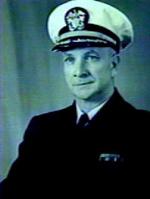


Captain Donald L. Creed Dies at 91
Headed “Thresher” Loss Research on Submarine Hulls
Donald L. Creed, 91, a Navy captain who served on the Official Board of Inquiry for the loss of the “Thresher” and also led the research on new steel for new deep dive submarines, died of pneumonia after a short illness on April 16, 2005, at Walter Reed Army Medical Center in Washington, D.C.
He was born and grew up in Marshfield, Mass., and graduated from Marshfield High School. Capt. Creed graduated from the Massachusetts Nautical School (now Massachusetts Maritime Academy) in 1933. He lived in Marshfield was a Marshfield WW II veteran. In 1983, he was the Mass. Maritime Academy’s Distinguished Alumnus.
Capt. Creed lived on Summer Street where his father owned the Creed “Mill by the Pond” that burned down in the 1950s. His father Andrew was a Town Selectman. Capt. Creed graduated from Marshfield High School in 1931 and played on the football team that was undefeated that year. His family of seamen was from Marshfield and Cohasset. His great uncle, Levi Creed, was Light House Keeper of Minot’s Ledge Light in the mid-19th century.
Captain Allen Hanson, Vice President, and a contingency of honor guard Cadets from the Mass Maritime Academy officiated at the grave-side ceremony at Cedar Grove Cemetery and presented an American flag to the family.
Capt. Creed, who was a Naval Architect and Marine Engineer, was in charge of the research that led to the successful development of HY 130 steel, a new high yield steel for the new deep diving submarines, following the loss of the nuclear attack submarine USS “Thresher” (SSN 593). On April 10, 1963, the Thresher and all her crew were lost while on sea trials 220 miles east of Boston. The submarine sank in 8,400 fathoms of water, a depth beyond the survival limit of the hull and beyond the capability of rescue. In 1966, when Capt. Creed was in charge of submarine steel research as the Director of the Hull Division, Naval Ship Systems Command, he was appointed to the Submarine Structural Steering Committee and the Submarine Steering Safety Task Group. The Committees, established as a direct result of the loss of the Thresher, were to oversee the hull aspects of the Navy’s submarine development, design, and construction program to ensure adequate safety features.
Capt. Creed received a Marine Engineering Degree from the Massachusetts Nautical School in 1933 and received a Naval Architecture Degree from the University of Michigan in 1942. He received a management Engineering Degree from Rensellaer Polytechnic Institute in 1951. He was licensed as a marine Chief Engineer and Professional Engineer.
After graduation from the Massachusetts Maritime Academy, he was an engineer on ships of the United Fruit and Mystic Steam Ship Fleets sailing out of Boston. Mass. Capt. Creed was commissioned in the Naval Reserve in 1937 and ordered to active duty in 1941. His early Navy tours were as an engineering duty officer in the Boston Navy Shipyard 1943-45, Puget Sound Naval Shipyard 1946-1948, and Ship Repair Superintendent Ship Repair Facility, Guam, 1949-1950. Later, he was at the U.S. Navy Department Bureau of Ships, Washington, D.C.,1952-1956; Staff Command, Amphibious Forces Atlantic Fleet, in Norfolk, VA., 1956-1960; Production Engineering Officer at Norfolk Naval Shipyard 1961-1963, and Hull Division Director, Naval Ship Systems Command, in Washington, D.C. 1964-1966.
In 1958, he was ordered to the Sixth Fleet to assist in the logistics of the landing of marines in Lebanon. He was on the “Thresher” Official Board of Inquiry in 1963 and in 1966, when Capt. Creed directed the Hull Division, he was in charge of research on a new high-yield steel.
In addition to World War II and Korean War service medals, Capt. Creed received the Navy Commendation medal for outstanding performance of duty in connection with the repair of battle damaged ships during World War II. He also received a Commendation from the Commander, Amphibious Forces, Atlantic Fleet, for outstanding achievement as Assistant Chief of Staff for Material and Logistics in obtaining significant improvement in the material condition and readiness of the ships in the Amphibious Forces.
After retirement from the Navy in 1966, he was a marine engineer at the Western Gear Corporation in Everett, Washington. After two years with that company, he accepted a civil service position with the Naval Ship Systems Command, Washington, D.C., as Head of the Fleet Modernization and Ship Cost Analysis Office. Two years later, he moved to the Research and Technology Directorate. As Head of the Surface Warfare System Analysis Office, he managed and directed the technical analysis and assessment of advanced ship and submarine combat systems.
Capt. Creed retired a second time in 1981 and worked as an engineering consultant and also as a marine surveyor for the Boat Owners Association of the United States.
He was an Alumnus Emeritus, University of Michigan, 1992 and Alumnus of the Year, Massachusetts Maritime Academy, 1983. He was a member of the: Reserve Officers Association; American Society of Naval Engineers; Society of Naval Architects and Marine Engineers and Registered Professional Engineer PE, Washington, DC; and the Annapolis Yacht Club.
His marriage to Helen C. Creed ended in divorce and to Antoinette H. Creed with her death from cancer in 1979.
Survivors include: Donald L. Creed, Jr., of Rockville, Maryland; Commander Andrew L. Creed, U.S.N. Retired, Pensacola, FL. Gordon S. Creed Esq., Wash, D.C.; and Laura C. Gordon, of Johnstown, Penn.; eight grandchildren and three great grandchildren.